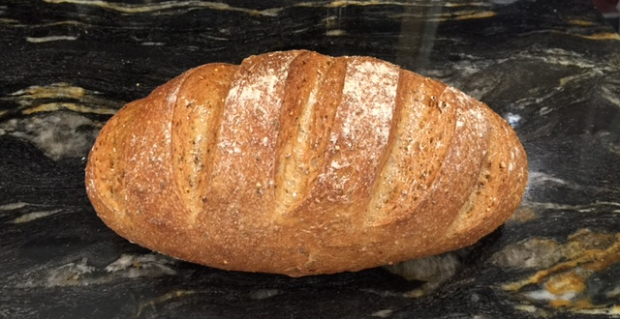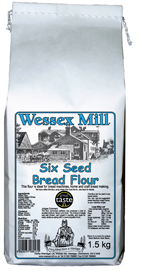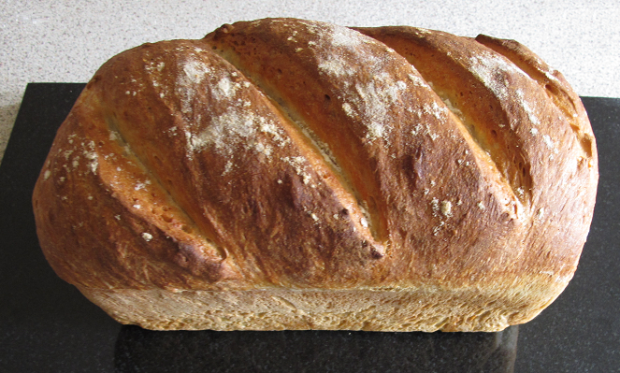
“Which Flour Do I Choose?”
Walk into any supermarket and head to the baking section. Once there, you will almost certainly be greeted with a bewildering selection of flours to choose from … supermarket brands, named brands, white, wholemeal, brown, organic, rye, seeded, pizza, the list goes on.
There will also be flours which, whilst they can be used to make bread, generally produce loaves that are inferior to those made with proper bread flour. These include plain (or all-purpose), self-raising and sponge.
So to make a loaf bread, which flour do you choose?
In The Beginning …
When setting out to bake bread for the first time by following a simple bread recipe, any supermarket brand of strong white bread flour is a good first choice. This will create a dough that is easy to manipulate and bake into a tasty loaf after a couple of tries. A single bag of flour (1.5kg) should be enough to get the basics sorted, as well as create a decent, doughy mess throughout the kitchen.
That was my experience when I started making bread. After this, I was keen to find out what loaves made from different flours tasted like. So I dived back into the baking section, picked a few flours, loaded them into the shopping trolley and started making all manner of breads.
After, of course, cleaning up the kitchen.
White, Brown and Wholemeal Wheat Flours
The difference between these three flours is down to the percentage extracted from the wheat grain during the milling process to make flour, and more importantly which parts of the grain. The more that is extracted, the more nutritional value the flour has.
- White flour – this has around 70% extracted. In addition to removing the nutritious ingredients, the flour may have been treated with chemicals to remove any discolouration.
- Wholemeal flour – this has 100% extraction, so the bread gets the full nutritional benefits of the raw materials. The dough can be a little harder to work and sometimes needs a bit more water when compared directly with white flour.
- Brown flour – lies between white and wholemeal, and the amount of extraction is determined by the flour producer, normally around 85%.
Ultimately it’s down to choice and taste, whether you want to eat white or non-white bread, and what is being baked. For a normal baking I use wholemeal (or a speciality flour). There are some occasions where using white flour is appropriate though. This includes pizza dough, French bread or Vietnamese “banh mi” sandwiches … for these I use white flour of some description.

I personally don’t use brown flour, if I want to make a non-white loaf I’ll use wholemeal . I see no point in a halfway house on the nutritional value of what I am eating. Also if I am making a non-white loaf, I would rather use flour that has the nutrients in it naturally rather than added afterwards.
Supermarket vs Named Brand
An internet search on this topic will reveal a myriad of articles readily available about whether named brands are better than supermarket brands, with discussion back and forth about tightness of crumb and other factors. Then there are the discussions about which supermarket has the best bread flour.
From my own experience at making loaves with both types, there’s not much difference between the major supermarket brands when baking a standard loaf. The named brands don’t warrant spending the extra money, in my view (a view shared by my wife after several taste tests). From the loaves I have made with named brand flours, there is no noticeable different to me between the crumb texture and flavour when compared with loaves made from supermarket brands. This excludes named brand speciality flours, e.g. Hovis Granary.
Mixing It Up With Speciality Flours
 There is a myriad of speciality flours available from supermarkets, health food stores and farm shops. Some flours are for a specific type of produce, e.g. making dough for pizza and calzone. Other flours come with a wide variety of ingredients added to enrich the loaf beyond that which standard flours offer.
There is a myriad of speciality flours available from supermarkets, health food stores and farm shops. Some flours are for a specific type of produce, e.g. making dough for pizza and calzone. Other flours come with a wide variety of ingredients added to enrich the loaf beyond that which standard flours offer.
Of particular note are flours with seed ingredients. These are quite popular and with just cause, as they add important vitamins and nutrients to the daily diet, as well as texture and extra depths of flavour to the bread itself.
Whichever speciality flour you choose to make bread, for the first attempt it’s worth making a loaf with a 50:50 mix of that flour and a flour you normally use. Then make one with 100% of the speciality flour and see which you prefer. Another approach is to go with two speciaility flours and a standard flour in thirds. It really is up to you, there are so many combinations of flavours to try out.
There are some worth highlighting that I have found make a noticeable difference (good and not so good):
- Spelt flour – an alternative to everyday wheat flour. Bread make using spelt flour has a nutty, slightly sweet taste to it. It needs slightly more water than normal flour, and also should be kneaded less. To begin with you can try a 50:50 mix of spelt and normal bread flour to get the feel for it.
- Pizza/Pasta flour – also known as “00” flour, this is very finely milled specifically for make pizza and pasta. I have tried making pizza with strong white bread flour and 00 flour, and have found that the latter does make a better pizza base.
- Canadian flour – available in white and wholemeal, this makes bread with a more even, tighter crumb. It also tends to rise more compared to standard bread flour.
- Rye flour – I tried making a loaf of bread with rye flour using the method I normally use. The dough did not rise. At all. Lesson learned. This is because rye is not wheat, it has much less gluten and that is needed to have an effective rise. However, it does have a very distinctive flavour, so adding 15% rye to a wheat-based flour mix can give an additional taste to the bread without impacting its ability to rise.
The Wessex Mill flour range has some interesting flours that are worth trying. They are normally available from farm shops. The two that I use regularly are:
- Six seed – this is my go-to flour for adding extra depth of flavour to a loaf as well as adding to its nutritional value. As the name suggests it contains six different types of seed, including poppy, sunflower and sesame. The flour when used by itself can result in a dense loaf with a very tight crumb, so I use a 50:50 mixture of this and standard strong white bread flour.
- Apple and Cinnamon – great for making tea cakes, spiced fruit loaves and hot cross buns. I have also used this when making pastries, e.g. raisan and cinnamon swirls.

Rye bread MUST have sourdough starter in it. Since I started baking with the Hamelman baking book and using sourdough starter, my ryes have been to-die-for!!
LikeLiked by 1 person
Yep, agreed. Unfortunately at the time I didn’t know this, as I was just starting out, hence the stunning lack of rise and loaf with the consistency of a brick. I do find though that adding a bit of rye flour into a wheat mix does bring the flavour through. I got this tip from one of Richard Bertinet’s books.
LikeLike